engine coolant SATURN ION 2004 User Guide
[x] Cancel search | Manufacturer: SATURN, Model Year: 2004, Model line: ION, Model: SATURN ION 2004Pages: 380, PDF Size: 2.89 MB
Page 243 of 380
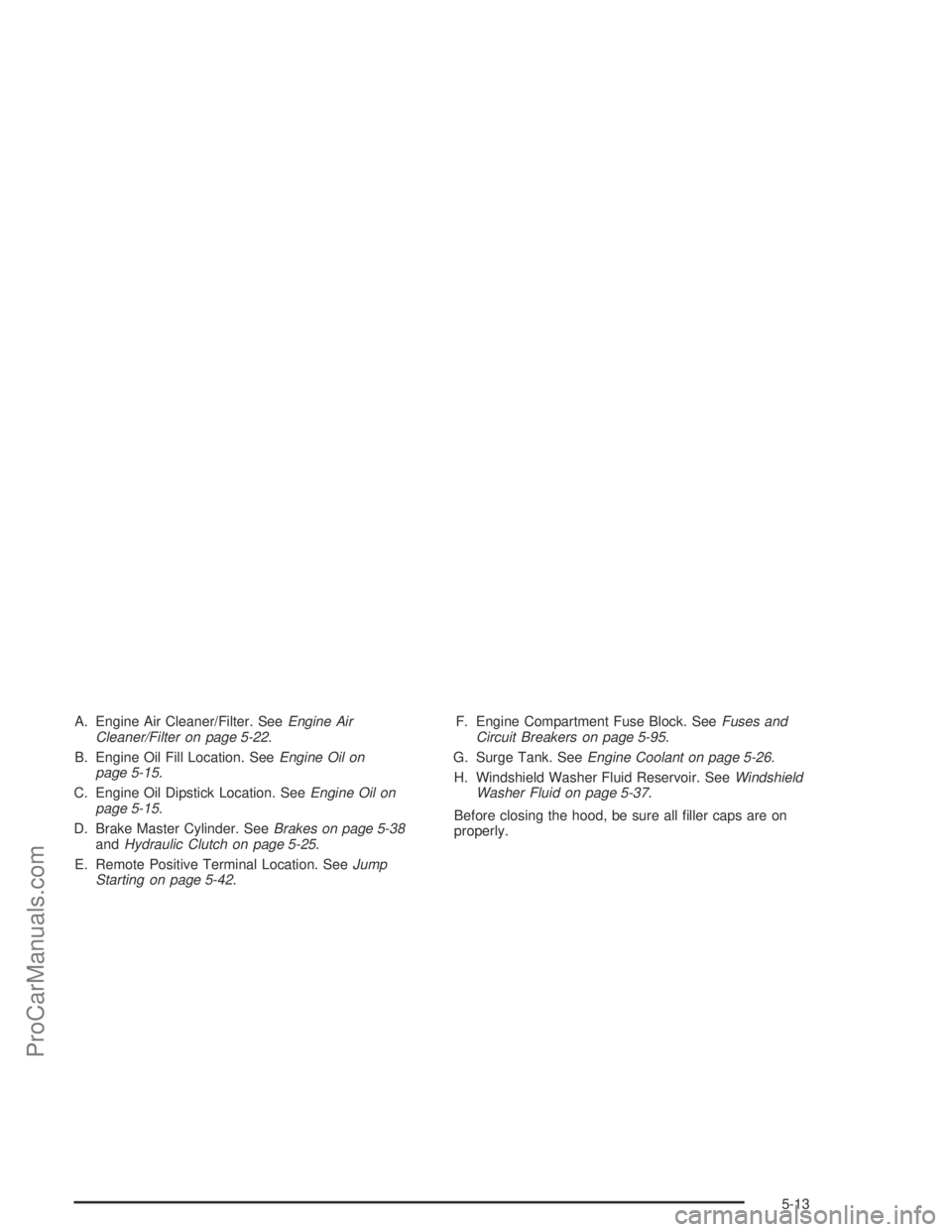
A. Engine Air Cleaner/Filter. SeeEngine Air
Cleaner/Filter on page 5-22.
B. Engine Oil Fill Location. SeeEngine Oil on
page 5-15.
C. Engine Oil Dipstick Location. SeeEngine Oil on
page 5-15.
D. Brake Master Cylinder. SeeBrakes on page 5-38
andHydraulic Clutch on page 5-25.
E. Remote Positive Terminal Location. SeeJump
Starting on page 5-42.F. Engine Compartment Fuse Block. SeeFuses and
Circuit Breakers on page 5-95.
G. Surge Tank. SeeEngine Coolant on page 5-26.
H. Windshield Washer Fluid Reservoir. SeeWindshield
Washer Fluid on page 5-37.
Before closing the hood, be sure all �ller caps are on
properly.
5-13
ProCarManuals.com
Page 245 of 380
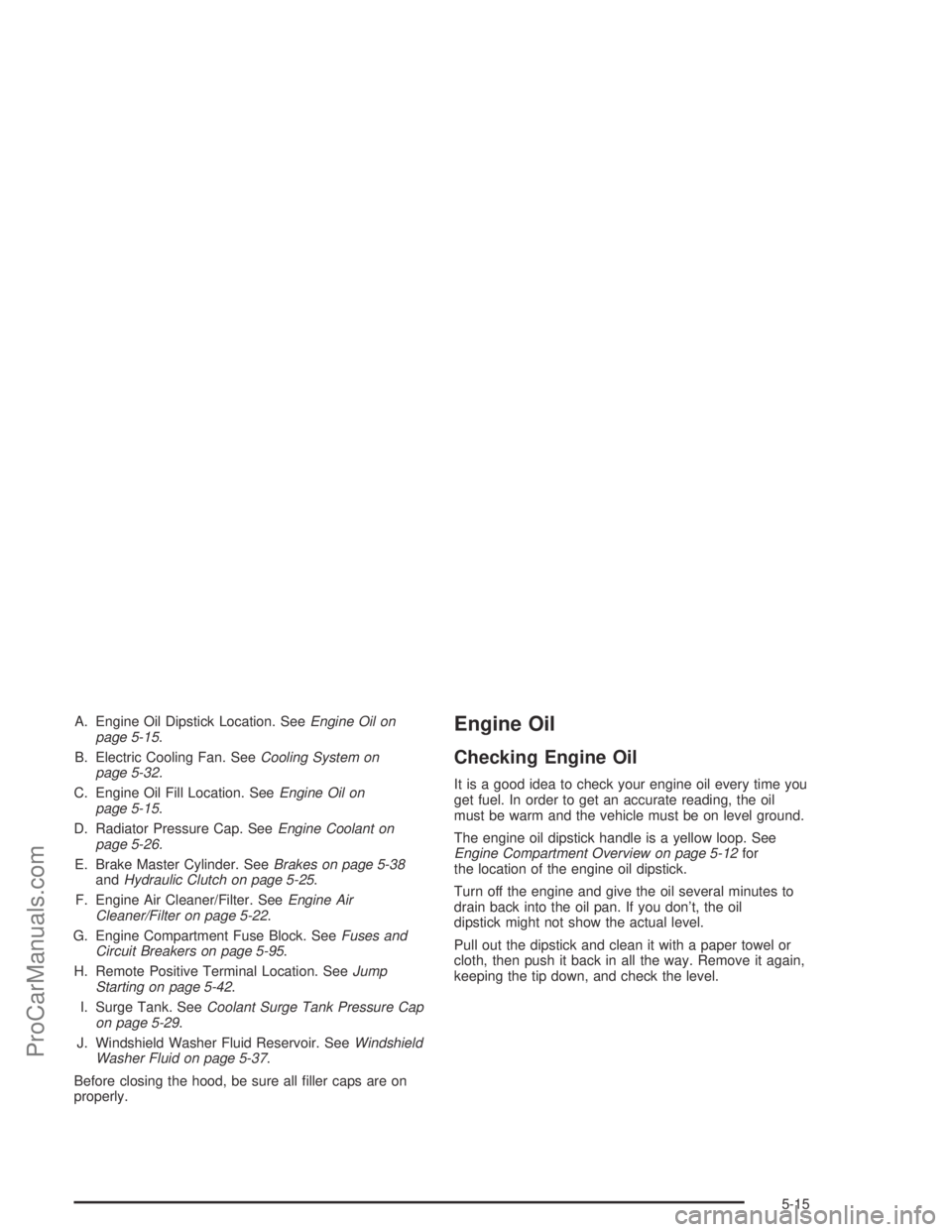
A. Engine Oil Dipstick Location. SeeEngine Oil on
page 5-15.
B. Electric Cooling Fan. SeeCooling System on
page 5-32.
C. Engine Oil Fill Location. SeeEngine Oil on
page 5-15.
D. Radiator Pressure Cap. SeeEngine Coolant on
page 5-26.
E. Brake Master Cylinder. SeeBrakes on page 5-38
andHydraulic Clutch on page 5-25.
F. Engine Air Cleaner/Filter. SeeEngine Air
Cleaner/Filter on page 5-22.
G. Engine Compartment Fuse Block. SeeFuses and
Circuit Breakers on page 5-95.
H. Remote Positive Terminal Location. SeeJump
Starting on page 5-42.
I. Surge Tank. SeeCoolant Surge Tank Pressure Cap
on page 5-29.
J. Windshield Washer Fluid Reservoir. SeeWindshield
Washer Fluid on page 5-37.
Before closing the hood, be sure all �ller caps are on
properly.Engine Oil
Checking Engine Oil
It is a good idea to check your engine oil every time you
get fuel. In order to get an accurate reading, the oil
must be warm and the vehicle must be on level ground.
The engine oil dipstick handle is a yellow loop. See
Engine Compartment Overview on page 5-12for
the location of the engine oil dipstick.
Turn off the engine and give the oil several minutes to
drain back into the oil pan. If you don’t, the oil
dipstick might not show the actual level.
Pull out the dipstick and clean it with a paper towel or
cloth, then push it back in all the way. Remove it again,
keeping the tip down, and check the level.
5-15
ProCarManuals.com
Page 256 of 380
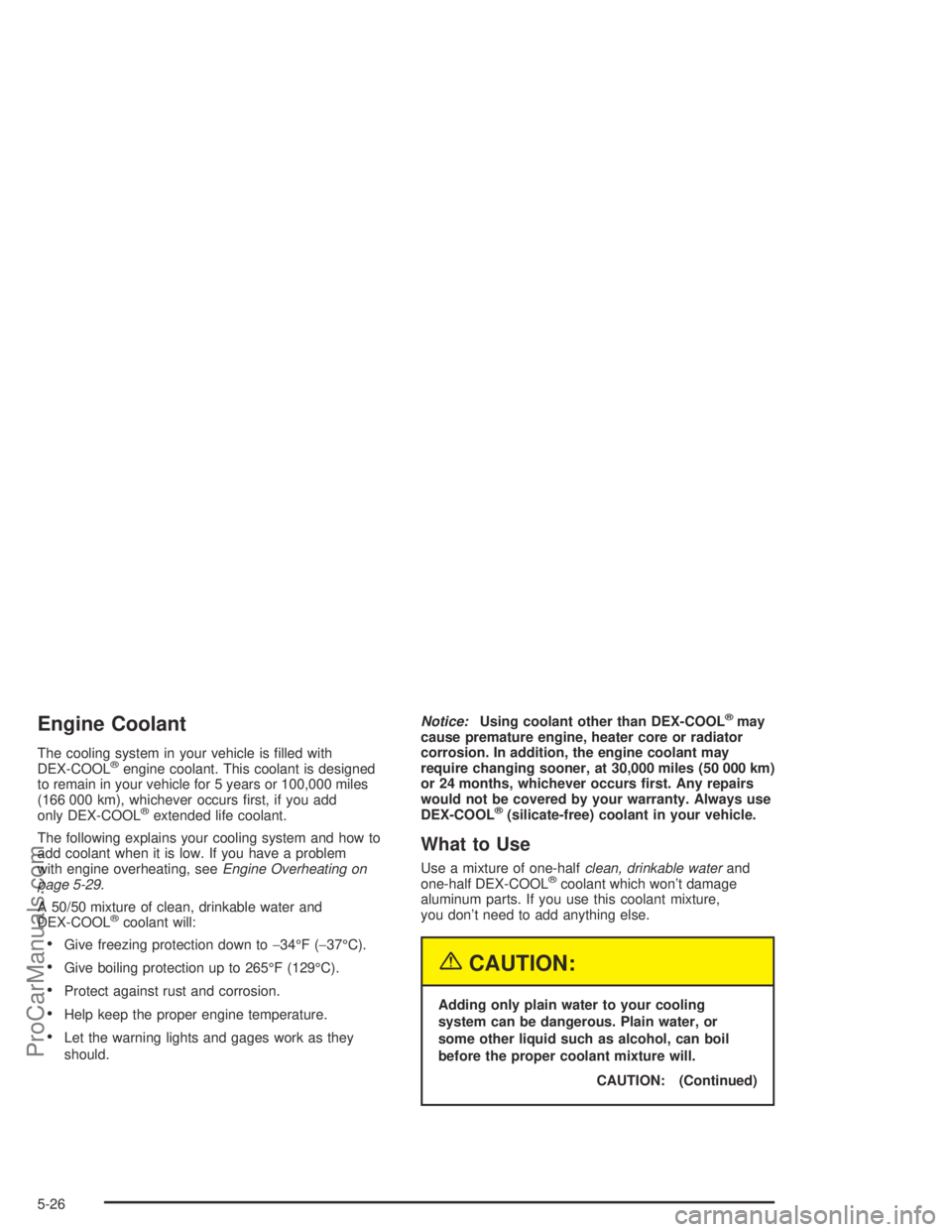
Engine Coolant
The cooling system in your vehicle is �lled with
DEX-COOL®engine coolant. This coolant is designed
to remain in your vehicle for 5 years or 100,000 miles
(166 000 km), whichever occurs �rst, if you add
only DEX-COOL
®extended life coolant.
The following explains your cooling system and how to
add coolant when it is low. If you have a problem
with engine overheating, seeEngine Overheating on
page 5-29.
A 50/50 mixture of clean, drinkable water and
DEX-COOL
®coolant will:
Give freezing protection down to−34°F (−37°C).
Give boiling protection up to 265°F (129°C).
Protect against rust and corrosion.
Help keep the proper engine temperature.
Let the warning lights and gages work as they
should.Notice:Using coolant other than DEX-COOL
®may
cause premature engine, heater core or radiator
corrosion. In addition, the engine coolant may
require changing sooner, at 30,000 miles (50 000 km)
or 24 months, whichever occurs �rst. Any repairs
would not be covered by your warranty. Always use
DEX-COOL
®(silicate-free) coolant in your vehicle.
What to Use
Use a mixture of one-halfclean, drinkable waterand
one-half DEX-COOL®coolant which won’t damage
aluminum parts. If you use this coolant mixture,
you don’t need to add anything else.
{CAUTION:
Adding only plain water to your cooling
system can be dangerous. Plain water, or
some other liquid such as alcohol, can boil
before the proper coolant mixture will.
CAUTION: (Continued)
5-26
ProCarManuals.com
Page 257 of 380

CAUTION: (Continued)
Your vehicle’s coolant warning system is set for
the proper coolant mixture. With plain water or
the wrong mixture, your engine could get too
hot but you would not get the overheat warning.
Your engine could catch �re and you or others
could be burned. Use a 50/50 mixture of clean,
drinkable water and DEX-COOL
®coolant.Notice:If you use an improper coolant mixture,
your engine could overheat and be badly damaged.
The repair cost would not be covered by your
warranty. Too much water in the mixture can freeze
and crack the engine, radiator, heater core and
other parts.
If you have to add coolant more than four times a year,
have your retailer check your cooling system.
Notice:If you use the proper coolant, you do not
have to add extra inhibitors or additives which claim
to improve the system. These can be harmful.
5-27
ProCarManuals.com
Page 258 of 380

Checking Coolant
The surge tank is located on the driver’s side of the
engine compartment. SeeEngine Compartment
Overview on page 5-12for more information on location.
{CAUTION:
Turning the surge tank pressure cap when the
engine and radiator are hot can allow steam
and scalding liquids to blow out and burn you
badly. Never turn the surge tank pressure
cap — even a little — when the engine and
radiator are hot.
The vehicle must be on a level surface. When your
engine is cold, the coolant level should be near the cold
�ll line. When your engine is warm, the level should
be at the cold �ll line or a little higher.
If the COOLANT warning message comes on and stays
on, it means you’re low on engine coolant. SeeLow
Coolant Level Warning Message on page 3-43.
5-28
ProCarManuals.com
Page 259 of 380

Adding Coolant
If you need more coolant, add the proper DEX-COOL®
coolant mixtureat the surge tank, but only when the
engine is cool. SeeCooling System on page 5-32
for instructions on how to add coolant to the coolant
surge tank.
{CAUTION:
You can be burned if you spill coolant on hot
engine parts. Coolant contains ethylene glycol,
and it will burn if the engine parts are hot
enough. Do not spill coolant on a hot engine.
When replacing the pressure cap, make sure it is
hand-tight.
Coolant Surge Tank Pressure Cap
Notice:If the pressure cap is not tightly installed,
coolant loss and possible engine damage may occur.
Be sure the cap is properly and tightly secured.
If you replace your coolant surge tank pressure cap,
a Saturn cap is required.
Engine Overheating
You will �nd a coolant temperature gage and a low
coolant level warning message on your vehicle’s
instrument panel. SeeEngine Coolant Temperature
Gage on page 3-35andLow Coolant Level Warning
Message on page 3-43. You also have a check
gage message and a transaxle �uid hot message.
SeeCheck Gage Message on page 3-44andTransaxle
Fluid Hot Message on page 3-42.
Notice:Driving with either the CHK GAGE message
or the COOLANT message displayed in the
message center and the Engine Coolant
Temperature Gage on your instrument panel in the
red zone could cause your vehicle to overheat.
See “Engine Overheating” underEngine Coolant on
page 5-26. Your vehicle could be damaged and
the damages might not be covered by your warranty.
5-29
ProCarManuals.com
Page 260 of 380
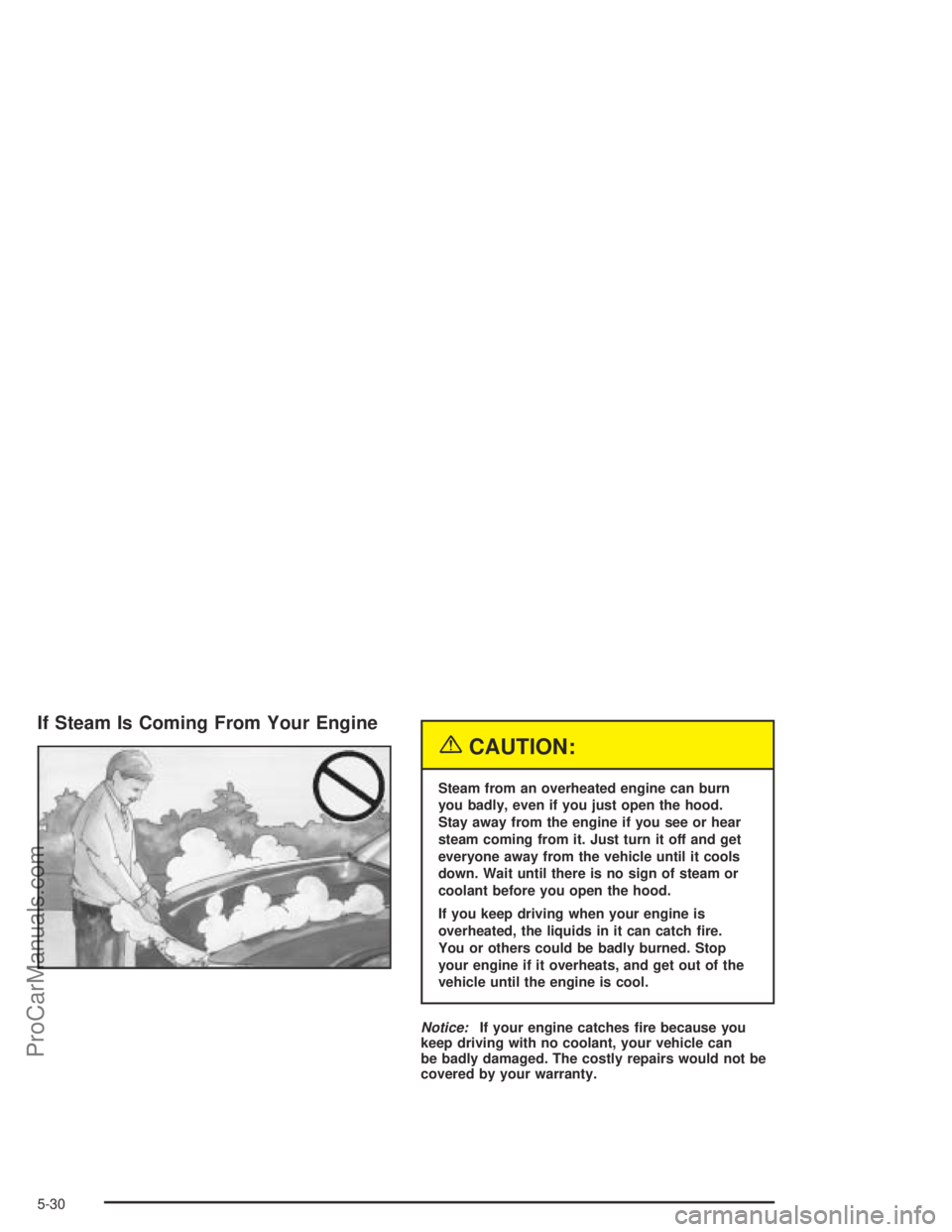
If Steam Is Coming From Your Engine
{CAUTION:
Steam from an overheated engine can burn
you badly, even if you just open the hood.
Stay away from the engine if you see or hear
steam coming from it. Just turn it off and get
everyone away from the vehicle until it cools
down. Wait until there is no sign of steam or
coolant before you open the hood.
If you keep driving when your engine is
overheated, the liquids in it can catch �re.
You or others could be badly burned. Stop
your engine if it overheats, and get out of the
vehicle until the engine is cool.
Notice:If your engine catches �re because you
keep driving with no coolant, your vehicle can
be badly damaged. The costly repairs would not be
covered by your warranty.
5-30
ProCarManuals.com
Page 261 of 380
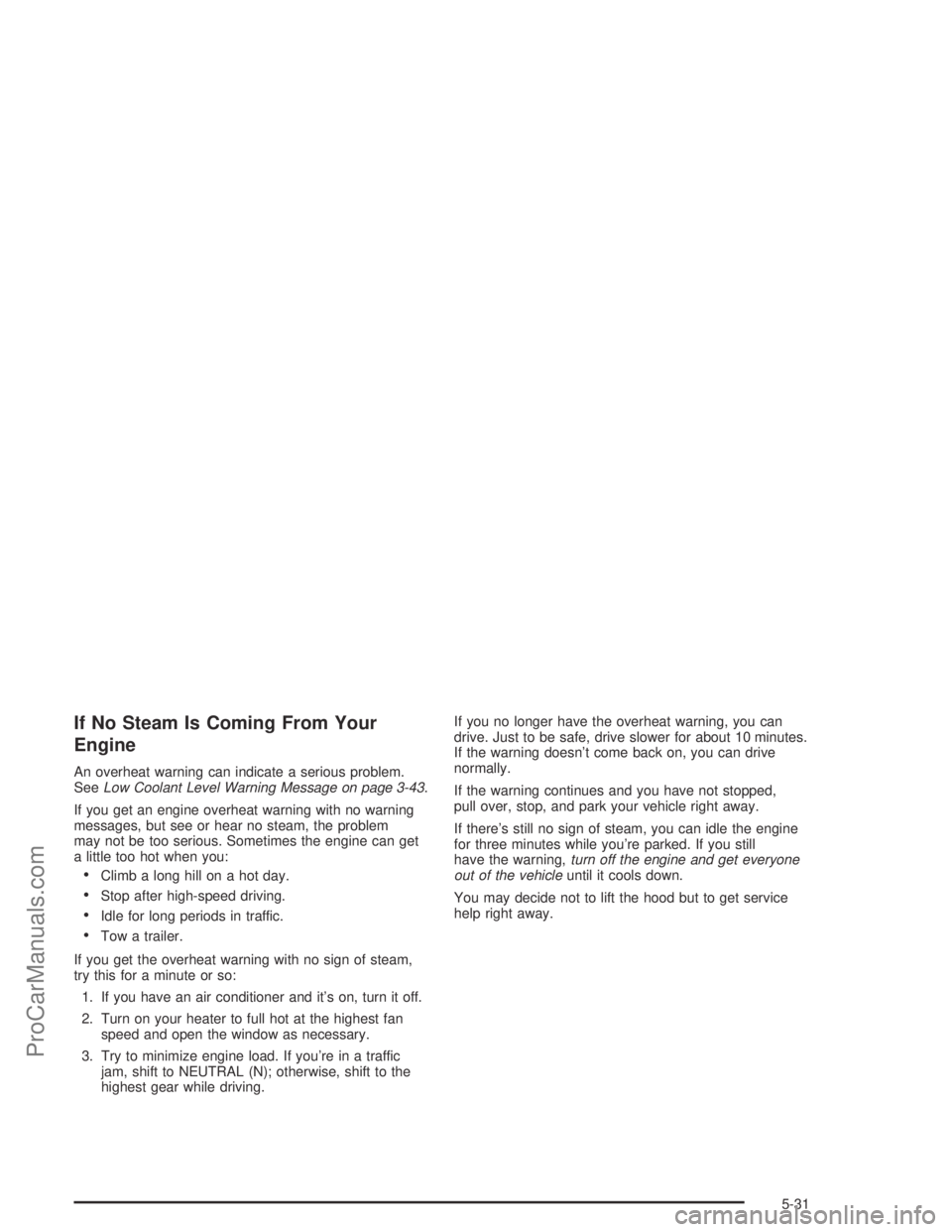
If No Steam Is Coming From Your
Engine
An overheat warning can indicate a serious problem.
SeeLow Coolant Level Warning Message on page 3-43.
If you get an engine overheat warning with no warning
messages, but see or hear no steam, the problem
may not be too serious. Sometimes the engine can get
a little too hot when you:
Climb a long hill on a hot day.
Stop after high-speed driving.
Idle for long periods in traffic.
Tow a trailer.
If you get the overheat warning with no sign of steam,
try this for a minute or so:
1. If you have an air conditioner and it’s on, turn it off.
2. Turn on your heater to full hot at the highest fan
speed and open the window as necessary.
3. Try to minimize engine load. If you’re in a traffic
jam, shift to NEUTRAL (N); otherwise, shift to the
highest gear while driving.If you no longer have the overheat warning, you can
drive. Just to be safe, drive slower for about 10 minutes.
If the warning doesn’t come back on, you can drive
normally.
If the warning continues and you have not stopped,
pull over, stop, and park your vehicle right away.
If there’s still no sign of steam, you can idle the engine
for three minutes while you’re parked. If you still
have the warning,turn off the engine and get everyone
out of the vehicleuntil it cools down.
You may decide not to lift the hood but to get service
help right away.
5-31
ProCarManuals.com
Page 262 of 380

Cooling System
When you decide it’s safe to lift the hood, here’s what
you’ll see:
A. Electric Engine Fan
B. Coolant Surge Tank with Pressure Cap{CAUTION:
An electric engine cooling fan under the hood
can start up even when the engine is not
running and can injure you. Keep hands,
clothing and tools away from any underhood
electric fan.
If the coolant inside the coolant surge tank is boiling,
don’t do anything else until it cools down. The vehicle
should be parked on a level surface.
5-32
ProCarManuals.com
Page 263 of 380

The coolant level should be at the cold �ll line. If it isn’t,
you may have a leak at the radiator hoses, heater
hoses, radiator, water pump or somewhere else in the
cooling system.
{CAUTION:
Heater and radiator hoses, and other engine
parts, can be very hot. Do not touch them.
If you do, you can be burned.
CAUTION: (Continued)
CAUTION: (Continued)
Do not run the engine if there is a leak. If you
run the engine, it could lose all coolant. That
could cause an engine �re, and you could be
burned. Get any leak �xed before you drive the
vehicle.
If there seems to be no leak, with the engine on, check
to see if the electric engine cooling fans are running.
If the engine is overheating, both fan should be running.
If it isn’t, your vehicle needs service. Turn off the
engine.
Notice:Engine damage from running your engine
without coolant is not covered by your warranty.
Notice:Using coolant other than DEX-COOL
®may
cause premature engine, heater core or radiator
corrosion. In addition, the engine coolant may
require changing sooner, at 30,000 miles (50 000 km)
or 24 months, whichever occurs �rst. Any repairs
would not be covered by your warranty. Always use
DEX-COOL
®(silicate-free) coolant in your vehicle.
5-33
ProCarManuals.com